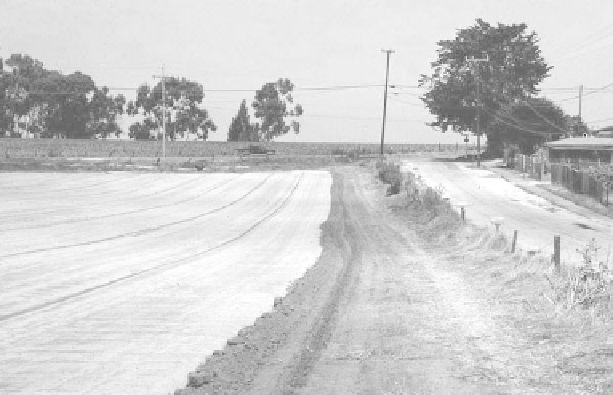Agriculture Reference
In-Depth Information
The present system of conventional strawberry production in California can be traced back to the early 1960s,
when the soil fumigant methyl bromide (MeBr) was introduced. Until that time, growers treated strawberries as a
perennial crop, with each field requiring rotation out of strawberries for several years. Use of methyl bromide
allowed growers to manage strawberries as an annual crop, planted year after year on the same piece of land. In
the system used since the 1960s, strawberry plants are removed each year following the end of the season in late
summer or early fall, then the soil is cultivated and fumigated before being replanted with new plants for the next
season. Intensive systems of drip irrigation, plastic mulch, and soil manipulation are required (Figure 20.3).
FIGURE 20.3
Conventional strawberry field fumigated with methyl bromide near Watsonville, California.
Vaporized
MeBr is held under the plastic for several days. Conversion to organic management involves replacing this very toxic and
expensive chemical with a variety of alternative inputs and practices.
Level 1 conversion
.
The first efforts related to conversion, carried out before the involvement of the Agroecology
Research Group, were focused as much on increasing yields and profitability as on changing the nature of the
production system. Extensive research was carried out to discover more effective ways of controlling pests and diseases
so that inputs could be reduced and their environmental impacts lessened. For example, different miticides for control
of the common pest two-spotted spider mite (
Tetranychus urticae
) were tested with the goal of overcoming the
problems of evolving mite resistance to the pesticides, negative impacts on non target organisms, pollution of ground
water, persistent residues on harvested berries, and health impacts for farm workers (Sances, 1982).
Level 2 conversion.
In the early 1980s, as interest in organic food became a potential market force in agriculture
and issues of pesticide safety and environmental quality came to the fore, farmers began to respond. It was in this
environment that researchers at UC Santa Cruz and a local farmer formed a partnership for conversion. In 1987,
this partnership became a comparative strawberry conversion research project. For three years, strawberries were
grown in plots using conventional inputs and management side by side with strawberries grown under organic
management. In the organic plots, each conventional input or practice was substituted with an organic equivalent.
For example, rather than control the two-spotted spider mite with a miticide, beneficial predator mites (
Phytoseiulis
persimilis
) were released into the organic plots. Over the three-year conversion period, population levels of the two-
spotted spider mites were monitored, releases of the predator carried out, and responses quantified. By the end of
the third year of the study, ideal rates and release amounts for the predator — now the norm for the industry —
had been worked out (Gliessman et al., 1996).
After the 3-years comparison study, researchers continued to observe changes and the farmer continued to
make adjustments in his input use and practices. This was especially true in regard to soilborne diseases. After a
few years of organic management, diseases such as
Verticillium dahliae
, a source of root rot, began to occur with
greater frequency. The response was to intensify research on input substitution. Initial experiments with mustard
biofumigation took place, adjustments in organic fertility management occurred, and mycorrhizal soil inoculants
were tested. But the agroecosystem was still basically a monoculture of strawberries, and problems with disease
increased.




Search WWH ::

Custom Search